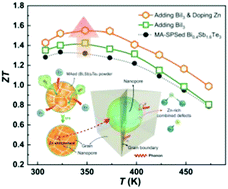High ZT in p-type thermoelectric (Bi,Sb)2Te3 with built-in nanopores†
Abstract
Peltier devices utilizing thermoelectric (TE) materials are expected to be used for precise temperature management in 5G and next-generation communication technologies. This demand has driven efforts to develop high-TE-performance Bi2Te3-based alloys. In this work, a significant TE performance enhancement was realized by simply incorporating a mixture of BiI3 and Zn into (Bi,Sb)2Te3 as dopants for both Te and Bi sites. Interestingly, the addition of BiI3 had little effect on doping, but it introduced many nanoscale pores that were effective at reducing the thermal conductivity. The unobvious deterioration in the electrical transport properties after adding trace amounts of BiI3 further improved the ZT value. Furthermore, the cationic Zn-doping of Bi sites improved the electrical conductivity and prevented its potential deterioration due to superfluous anionic I-doping. The neutralized Zn defects were observed as defect clusters on the inner surface of the nanopores, which might have further reduced the lattice thermal conductivity. Benefitting from the synergistic modulation of thermal and electrical transport properties, the ZT value was significantly improved to 1.55 at 348 K with a measured TE conversion efficiency of 5.2%. This work discloses a facile method for the development of high-performance (Bi,Sb)2Te3-based alloys, which may also be applicable to other TE materials.



 Please wait while we load your content...
Please wait while we load your content...